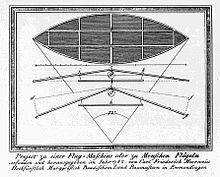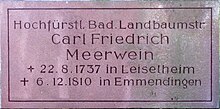Carl Friedrich Meerwein

Carl Friedrich Meerwein (born August 2, 1737 in Leiselheim , † December 6, 1810 in Emmendingen ) was a German "margravial Baden land builder" and designer of a flying machine.
Live and act
After a short apprenticeship in Karlsruhe, Carl Friedrich Meerwein, son of a pastor, went to the University of Strasbourg to study mathematics , physics and engineering . He also studied logic , agriculture , economic chemistry and physics in Jena . After graduating in “civil architecture ” in Strasbourg, he became a cammer accessist and in 1769 received a position as a 'master builder' with the Margrave of Baden. He was responsible for the entire construction industry in the 'upper margraviate' around Emmendingen to Lörrach. Among many other things, the Neue Landvogtei was built in Emmendingen from 1788–1790 according to Meerwein's plans in the classicism style as an administrative building and apartment for the governor. (There is no evidence to support the assumption that it was built as a widow's residence for the second wife of Margrave Karl-Friedrich, Luise Karoline Geyer zu Geyersberg, later Countess Hochberg.)
In addition to his professional duties, he dealt with the possibility of flying. During this time there were numerous (failed) attempts with flying machines in Europe, such as that of the French pioneer Jean-Pierre Blanchard . The hot-air gondolas, with which the Montgolfier brothers caused a sensation in June 1783, were for Meerwein "aerostatic balls" which enabled more "swimming in the air, like the fish in the water, than flying like the birds". For him they were not trend-setting, especially since the balloons could not be steered and could not rise even when it was raining.
His study of 1782, published in the journal Oberrheinische Mannigfaltheiten and in 1784 in Basel with detailed drawings as a book, was based on studies of birds. Meerwein took the proportions of the body and wings of bird species such as mallard , consecration , Gray Heron , Great Bustard , mute swan , long-eared owl , jackdaw , woodcock and partridge , and thus given a wing surface, which was necessary, in his view, so that a man could fly. In terms of his person, he came up with a wing area of 126 square shoes, which corresponds to about 12 m². The flying machine he calculated in this way, christened the Ornithopter , was allowed to have a maximum total weight of 200 pounds (approx. 100 kg).
The plane should be fastened in special "pants" under the center of gravity of the wings. The control should be done in such a way that the pants are lengthened and can be spread with the feet - like the tail feathers of a bird. In contrast to today's kites, to which his apparatus resembled externally, the wings - as with birds - were movable. However, Meerwein underestimated the effort that would be required to move the wings. In addition, the wings did not have a profile that could produce lift.
According to Encyclopaedia Britannica , Meerwein is said to have made a successful flight in 1781 with an 'ornithopter' he designed. This would have been the first flight with muscle power in human history. According to other sources, alleged attempts to fly failed in 1784 and 1785. In 1784 he allegedly took off with his flying machine on the Burgberg near Emmendingen on a nearly 150 m (!) Flight and landed on the 'dung heap of Engelwirt'. A second alleged attempt, which he is said to have made in Gießen in the summer of 1785 , where his brother-in-law Johann August Schlettwein was the dean of the first German university faculty for economics, has been handed down as unsuccessful by Joachim Heinrich Campe .
Even the attempt to fly in 1781 is an inexplicable legend. After no evidence could be found from the 18th and 19th centuries, according to which such a flight attempt took place, the legend began at the beginning of the 20th century. At the beginning there is Rosa Hagen, who wrote in 1912: "In 1781 he had completed a flying machine with which he attempted a flight by flying down from the castle and landing in the courtyard of the current Gasthaus zum Engel." With the novella Mr. Meerwein's Vogel by Toni Rothmund, published in 1925 , the legend received literary honors and has since been changed and expanded more and more. There are also no direct witnesses for the flight attempt allegedly made in Gießen. The Meerwein researcher and former Mayor of Emmendingen Ulrich Niemann writes: "Meerwein himself wrote on June 17, 1784 that he did not fly, that the model he built does not correspond to the dimensions he had calculated or the recommended and drawn dimensions ...".
Based on these “experiences”, Meerwein himself advised in his work from 1784: “The safest area to face an apprentice in this new art without risking his first attempt would be deep water, directly below a somewhat considerable rise: like that at that so-called Rhine jump in Basel. - For whoever falls into somewhat deep water does not break his neck or leg, and there are sufficient means of protection against drowning. "
Obviously, he didn't quite trust his own aircraft and therefore recommended something that the “Schneider von Ulm” did a few decades later - he too was unsuccessful.
The flying machine that Meerwein had built is said to have been in storage in Emmendingen for over 100 years. Without evidence, it is reported that a grandson of the aviation pioneer "disposed of" him during clean-up work at the end of the 19th century.
Meerwein finds a literary mention in Robur the Conqueror by Jules Verne : "In 1781 the architect of the Prince of Baden, Meerwein, constructed a bird flying machine and opposed the idea of ever being able to control the aerostats that had just been invented". Verne thus ranks him among the pioneers of flying with apparatuses heavier than air, but does not address the question of whether Meerwein actually flew.
After 1784 Meerwein worked again mainly as a very productive agricultural master. Among other things, in 1802 he published his structural research results on the properties and effects of the vaults . He also dealt with hydraulic engineering topics such as the calculation of barrages or the straightening of rivers.
Meerwein died in 1810 after falling from a horse. A summary of the planned and / or built, still existing or disappeared buildings by this early classical master builder is still missing today.
Commemoration
In Emmendingen there is the CF Meerwein elementary school and the municipal Meerwein children's house . There is also a sea wine route there . There is a sea wine fountain in the town square . There is also a Meerweinstrasse in Giessen , in the area of the “Am alten Flughafen” building area.
Trivia
Since 2010, the city buses in Emmendingen have been named after well-known personalities who were born in the city or who lived and worked there temporarily, including Cornelia Goethe , Jakob Michael Reinhold Lenz , Johann Georg Schlosser and Carl Friedrich Meerwein . The name Meerwein is on the side of the bus; supplemented by brief biographical information.
The Emmendinger Sportflieger-Club is named after the aviation pioneer.
Fonts
- The art of flying like birds. HL Brönner and JJ Thurneysen d. J., Frankfurt am Main / Basel 1784 Google digitized
- The human being! shouldn't he also be born with the ability to fly? JJ Thurneysen, Jünger, Basel 1784 doi : 10.3931 / e-rara-43022
- Contribution to the correct assessment of the properties and effects of the vaults: as well as to the adequate naming of the parts thereof; In addition to instructions derived from them, all types of vaults and especially bridge vaults. Guilhauman, Frankfurt am
Main 1802 Google digitized
literature
- Max Lehrer: The art of flying in historical lighting. In: Illustr. Aaron. Communications, VIII, 9. Strasbourg 1904, pp. 269–302.
- Clive Hart: The dream of flight; aeronautics from classical times to the Renaissance. Faber and Faber, London 1972.
- Clive Hart: Carl Friedrich Meerwein's ornithopter. 1980
- Lothar Mayer (ed.): The district of Emmendingen. Konrad Theiss, Stuttgart 1981.
- Heinz Straub: Carl Friedrich Meerwein: a forgotten aviation pioneer. In: look into history; Karlsruhe contributions to the history of the city. 34. Karlsruhe 1997, pp. 5-7.
- Clive Hart: The Prehistory of Flight. University of California Press, Berkeley 1985.
- Municipality of Sasbach (ed.): Carl Friedrich Meerwein: a famous Leiselheimer. In: Leiselheim. Sasbach 1999, pp. 225-228.
- Ulrich Niemann: Carl Friedrich Meerwein - the first aviator? In: Emmendinger Chronik 2008. Emmendingen 2008, pp. 33–37.
- Ulrich Niemann: Carl Friedrich Meerwein - the first aviator? In: Yearbook of the district of Emmendingen for culture and history, 23. Emmendingen 2009, pp. 8-18.
Web links
- Encyclopaedia Britannica: history of transportation ( Memento of February 11, 2006 in the Internet Archive )
- Stephan Scholz: Landed faster “than he liked”. In: Gießener Anzeiger from April 25, 2015, accessed on June 30, 2016
Individual evidence
- ↑ according to information from the mayor of Leiselheim on July 31, 2012 correct date of birth as noted in the church register
- ↑ See: U. Niemann in: Emmendinger Stadtchronik 2009. P. 42.
- ↑ Joachim Heinrich Campe: The publisher's journey from Hamburg to Switzerland in 1785. In: Collection of interesting and consistently functional travelogues for the young. Second part. Wolfenbüttel 1786, pp. 170-173. Google digitization
- ↑ See Rosa Hagen: Emmendingen as the scene of Goethe's Hermann and Dorothea. Emmendingen 1912, p. 10.
- ↑ Cf. on this: Ulrich Niemann: Carl Friedrich Meerwein - the first aviator? In: Emmendinger Chronik. Edition 2008, pp. 33–37.
- ↑ The art of flying like birds. P. 41.
- ↑ See on this: Jules Verne: Robur-le-Conquérant. Paris 1886; quoted in Zurich 1977, p. 87; see also zeno.org with a slightly different translation
- ^ Homepage of the Sports Aviation Club Carl Friedrich Meerwein e. V.
| personal data | |
|---|---|
| SURNAME | Meerwein, Carl Friedrich |
| BRIEF DESCRIPTION | German builder and designer of a flying machine |
| DATE OF BIRTH | August 2, 1737 |
| PLACE OF BIRTH | Leiselheim |
| DATE OF DEATH | December 6, 1810 |
| Place of death | Emmendingen |




